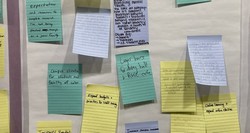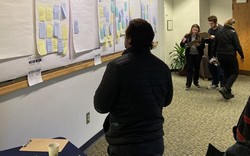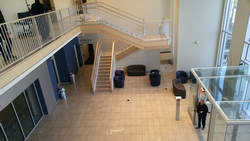Monmouth University administration held a “strategic plan-a-thon,” inviting students, faculty, and staff to share their ideas for campus-wide changes and improvements last Wednesday.
In preparation for the crafting of a new strategic plan following Patrick F. Leahy, Ed.D.’s installation as University President, the administration organized a kick-off event during which the students, faculty, and staff of Monmouth were encouraged to contribute their own ideas and thoughts via sticky notes on boards with different categories.
Responses during the 8-hour event were collected by members of the Strategic Planning Steering Committee to be taken into consideration when building the new plan.
The four headings under which the MU community were able to place their thoughts were: “Start,” for brand new ideas; “Stop,” for current practices which may not have a place in the plan; “Enhance,” for improving current practices; and “Dream Big,” regarding large-scale ideas for positive change at the school.
These four categories together were the focus of the event, which took place from 10 a.m. to 6 p.m. in the Anacon Lobby of the Student Center.
The focus of the plan-a-thon was the gathering of ideas by the Strategic Planning Steer people of MU and determine how the strategic plan should be shaped to best cater to the requests of the community. Amanda Klaus, Executive Director for Alumni Engagement and Annual Giving and a member of the Strategic Planning Steering Committee, explained the format of the event. “The categories are broad enough that they allow everybody who wants a chance to participate to really help the University move in a more strategic direction,” she said. “They provide a really great opportunity for folks to share ideas both big and small.”
 “What we as a committee will do is look at what people want; what direction the University wants to go in,” said Chris Hirschler, Ph.D., MCHES, Chair of Health and Physical Education Department and member of the Strategic Planning Steering Committee.
“What we as a committee will do is look at what people want; what direction the University wants to go in,” said Chris Hirschler, Ph.D., MCHES, Chair of Health and Physical Education Department and member of the Strategic Planning Steering Committee.
“As an example, some faculty have said to me, ‘Oh, you’re representing the School of Nursing and Health Studies,’ because that’s where I reside,” Hirschler added. “But I said ‘no,’ because on the Committee I represent the students, faculty, and staff of the University. What I want to see is what the masses want added, changed, or taken away.”
Many people took advantage of this opportunity to voice their opinions about what could make MU a better place, with responses covering a range of topics. Among staff and faculty, benefits like on-campus daycare and more opportunities for entry- and mid-level employees to be promoted were common suggestions on the boards. Among students, however, hot topics included better parking, abolishing fixed course framework for graduate students, a commuter lounge, and a tuition price cap.
Some students have firsthand experience which spurred them to contribute to the conversation. David Grossi, a senior biology student and former resident advisor, used his experience to suggest renovations to the housing system at Monmouth. “It was interesting to be able to work in buildings both on- and off-campus,” Grossi said. “The buildings are very versatile and can be multipurpose. So, trying to get better-quality housing for students with the money the University has made would be a good idea.”
Multiple suggestions made by faculty, staff, and students concerned the welfare and comfort of international students. As Hafsa Ijaz, a junior accounting student, explained, “I’m originally from Pakistan, but I am a permanent resident of the United States. But for students here as non-residents, tuition can be very high.” Additionally, many suggestions were made by the community regarding services for students and employees of color.
Mary Anne Nagy, Vice President for Student Life and Leadership Engagement, explained that the end goal of the event is to essentially crowd source ideas to inspire the forthcoming strategic plan. “The plan-a-thon has been a really great gathering event,” Nagy said. “In addition to kicking it off, the event makes everyone within the community––our faculty, our staff, and our students––feel like they have a role to play in the future of our school.”
Leahy, who is currently in the first semester of his tenure as President of Monmouth University, personally oversaw the event, taking into consideration many of the ideas which were presented on the boards throughout the day.
He explained his excitement at spearheading the strategic plan, “For me, the big thing is to come in as a new president––even one who’s been a president before––and to not assume I have all the answers, but rather that I can be helpful in leading a process where we can come up with collective wisdom of our campus community; to make a plan that I can get excited about that I can dedicate my life to leading in the coming years.”
Regarding the creative process behind the strategic plan, Leahy said, “I want someone to try to imagine if we had not created Monmouth University and it wasn’t 86 years old: what would we create on this space if we could? That’s a pretty fundamental question.”
PHOTOS TAKEN by Alex Dyer



